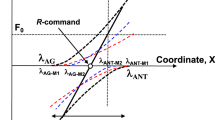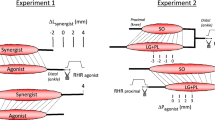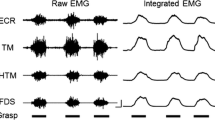Abstract
The main belly of the macaque's flexor digitorum profundus (FDP) is divided by a dissectible plane into radial and ulnar regions. The present report describes three findings which suggest that the radial and ulnar regions represent separate functional subdivisions of the FDP. First, electromyographic (EMG) recordings during individuated finger movements performed by rhesus monkeys demonstrated different patterns of activation in the radial versus the ulnar region of the FDP. Second, studies of single motor units discriminated from the parent EMG activity also suggested at least two differentially activated motoneuronal pools in the radial versus ulnar region. Third, the finger movements evoked by intramuscular stimulation, delivered through the recording electrodes, indicated that contraction of the radial versus ulnar region produces different patterns of tension on the finger tendons. Together these findings suggest that the radial and ulnar regions of the FDP provide differential tension on the finger tendons to individuate finger movements.
Similar content being viewed by others
References
Armstrong JB, Rose PK, Vanner S, Bakker GJ, Richmond FJR (1988) Compartmentalization of motor units in the cat neck muscle, biventer cervicis. J Neurophysiol 60: 30–45
Balice-Gordon RJ, Thompson WJ (1988) The organization and development of compartmentalized innervation in rat extensor digitorum longus muscle. J Physiol (Lond) 398: 211–234
Basmajian JV, Stecko G (1962) A new bipolar electrode for electromyography. J Appl Physiol 17: 849
Berringer OM, Browning FM, Schroeder CM (1968) An atlas and dissection manual of rhesus monkey anatomy. Anatomy Laboratory Aids, Tallahassee, Fla.
Burke RE (1991) Selective recruitment of motor units. In: Humphrey DR and Freund HJ (eds) Motor control: concepts and issues. Wiley, New York, pp 5–21
Chanaud CM, Macpherson JM (1991) Functionally complex muscles of the cat hindlimb. III. Differential activation within biceps femoris during postural perturbations. Exp Brain Res 85: 271–280
Chanaud CM, Pratt CA, Loeb GE (1991a) Functionally complex muscles of the cat hindlimb. II. Mechanical and architectural heterogeneity within the biceps femoris. Exp Brain Res 85: 257–270
Chanaud CM, Pratt CA, Loeb GE (1991b) Functionally complex muscles of the cat hindlimb. V. The roles of histochemical fibertype regionalization and mechanical heterogeneity in differential muscle activation. Exp Brain Res 85: 300–313
Emonet-Dénand F, Laporte Y, Proske U (1971) Contraction of muscle fibers in two adjacent muscles innervated by branches of the same motor axon. J Neurophysiol 34: 132–138
English AW (1984) An electromyographic analysis of compartments in cat lateral gastrocnemius muscle during unrestrained locomotion. J Neurophysiol 52: 114–125
English AW, Letbetter WD (1982) Anatomy and innervation patterns of cat lateral gastrocnemius and plantaris muscles. Am J Anat 164: 67–77
English AW, Weeks OI (1984) Compartmentalization of single muscle units in cat lateral gastrocnemius. Exp Brain Res 56: 361–368
English AW, Weeks OI (1987) An anatomical and functional analysis of cat biceps femoris and semitendinosus muscles. J Morphol 191: 161–175
English AW, Weeks OI (1989) Electromyographic cross-talk within a compartmentalized muscle of the cat. J Physiol (Lond) 416: 327–336
Fetz EE, Cheney PD (1980) Postspike facilitation of forelimb muscle activity by primate corticomotoneuronal cells. J Neurophysiol 44: 751–772
Fritz N, Schmidt C, Yamaguchi T (1992) Biomechanical organization of single motor units in two multi-tendoned muscles of the cat distal forelimb. Exp Brain Res 88: 411–421
Galvas PE, Gonyea WJ (1980) Motor-end-plate and nerve distribution in a histochemically compartmentalized pennate muscle in the cat. Am J Anat 159: 147–156
Goodman LA (1954) Kolmogorov-Smirnov tests for psychological research. Psychol Bull 51: 160–168
Hammond CGM, Gordon DC, Fisher JT, Richmond FJR (1989) Motor unit territories supplied by primary branches of the phrenic nerve. J Appl Physiol 66: 61–71
Herring SW, Grimm AF, Grimm BR (1979) Functional heterogeneity in a multipinnate muscle. Am J Anat 154: 563–576
Howell AB, Straus WL (1933) The muscular system. In: Hartman, Straus (eds) Anatomy of the rhesus monkey. Hafner, New York, pp 89–175
Lemon RN, Mantel GWH, Rea PA (1990) Recording and identification of single motor units in the free-to-move primate hand. Exp Brain Res 81: 95–106
Loeb GE, Gans C (1986) Electromyography for experimentalists. University of Chicago Press, Chicago
Massey FJ (1951) The Kolmogorov-Smirnov test for goodness of fit. J Am Stat Assoc 46: 68–78
Paré EB, Stern JT, Schwartz JM (1981) Functional differentiation within the tensor fasciae latae. J Bone Joint Surg [Am] 63: 1457–1471
Pratt CA, Loeb GE (1991) Functionally complex muscles of the cat hindlimb. I. Patterns of activation across sartorius. Exp Brain Res 85: 243–256
Pratt CA, Chanaud CM, Loeb GE (1991) Functionally complex muscles of the cat hindlimb. IV. Intramuscular distribution of movement command signals and cutaneous reflexes in broad, bifunctional thigh muscles. Exp Brain Res 85: 281–299
Richmond FJR, MacGillis DRR, Scott DA (1985) Muscle-fiber compartmentalization in cat splenius muscles. J Neurophysiol 53: 868–885
Schieber MH (1991) Individuated finger movements of rhesus monkeys: A means of quantifying the independence of digits. J Neurophysiol 65: 1381–1391
Schieber MH, Thach WT (1985) Trained slow tracking. I. Muscular production of wrist movement. J Neurophysiol 54: 1213–1227
Segal RL, Wolf SL, DeCamp MJ, Chopp MT, English AW (1991) Anatomical partitioning of three multiarticular human muscles. Acta Anat 142: 261–266
Serlin DM, Schieber MH (1993) Morphologic regions of the multitendoned extrinsic finger muscles in the monkey forearm. Acta Anat (in press)
Szebenyi ES (1969) Atlas of Macaca mulatta. Fairleigh Dickinson University Press, Rutherford, NJ.
Author information
Authors and Affiliations
Rights and permissions
About this article
Cite this article
Schieber, M.H. Electromyographic evidence of two functional subdivisions in the rhesus monkey's flexor digitorum profundus. Exp Brain Res 95, 251–260 (1993). https://doi.org/10.1007/BF00229783
Received:
Accepted:
Issue Date:
DOI: https://doi.org/10.1007/BF00229783




